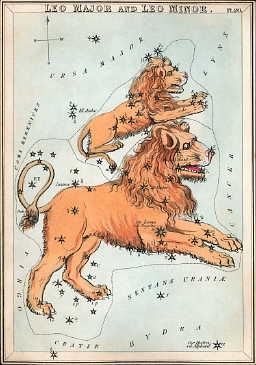Our annual fund-raiser ends May 5. EarthSky needs your help to keep going! Please donate!
Want to donate via PayPal or send a check to EarthSky? Click here.
Tonight – May 3, 2017 – and tomorrow night, look outside for the moon and find the star Regulus nearby. Regulus is the brightest star in the constellation Leo the Lion. As seen from North America and much of the world, the moon will appear to the west of Regulus on the night of May 3, and then to the east of Regulus on the nights of May 4 and May 5.
That much-brighter point of light to the east of the moon and Regulus is the king planet Jupiter, brightest starlike object in the evening sky. From most places worldwide, the waxing gibbous moon will pair up most closely with Jupiter on the evening of May 7.
Our friends in Australia and New Zealand can watch the moon occult (pass in front of) Regulus on the evening of May 4, 2017. Regulus will disappear behind the dark side of the moon and reappear on the moon’s illuminated side. The occultation starts at or near sunset on the Australian west coast but after nightfall at more easterly Australian locations. For your convenience, we give the occultation times in local time for Perth (Western Australia) and Sydney (New South Wales):
Perth, Western Australia
Occultation begins: 5:15 p.m. AWST
Occultation ends: 6:01 p.m. AWST
Sydney, New South Wales
Occultation begins: 9:14 p.m. AEST
Occultation ends: 10:35 p.m. AEST

Want more information? Click here to find out the occultation times for numerous localities in Australia and new Zealand in Universal Time. Remember that you must convert from Universal Time to your local time. Here’s how.
Tonight’s moonlit glare might make it hard to see that Regulus dots the bottom of a backwards question mark pattern of stars. This pattern is known as The Sickle, and it outlines the Lion’s head and mane. Regulus, meanwhile, is often called the Lion’s Heart.
The name for Leo’s second brightest star, Denebola, comes from an Arabic term which translates to the Lion’s Tail. Two other stars – Zosma and Chertan – form a noticeable triangle with Denebola to draw out the hindquarters and tail of Leo the Lion. (See the chart of Leo the Lion below.)

The waxing moon will make it difficult to envision the celestial Lion this upcoming week. However, if you can locate the star Regulus, you can view the Lion in all his starlit majesty during the upcoming moon-free evenings in the last week week of May and the first week of June.


Are you familiar with the Big Dipper? If so, this star formation serves as a wonderful guide to the Leo star Regulus.
From mid-northern latitudes, the upside-down Big Dipper shines way up high in the northern sky as darkness falls. The Big Dipper is even visible from the southern tropics, though it sits lower down in their northern sky on these May and June evenings.
Draw an imaginary line from the star Megrez and through the star Phecda, and then take a long jump to the star Regulus. Try this star-hopping trick tonight. Then try it again when the moon leaves the evening sky in another couple weeks.
Bottom line: On the night of May 3, 2017, the bright star near the moon is Regulus, the brightest star in the constellation Leo the Lion, often called the Lion’s Heart.
Enjoying EarthSky so far? Sign up for our free daily newsletter today!












